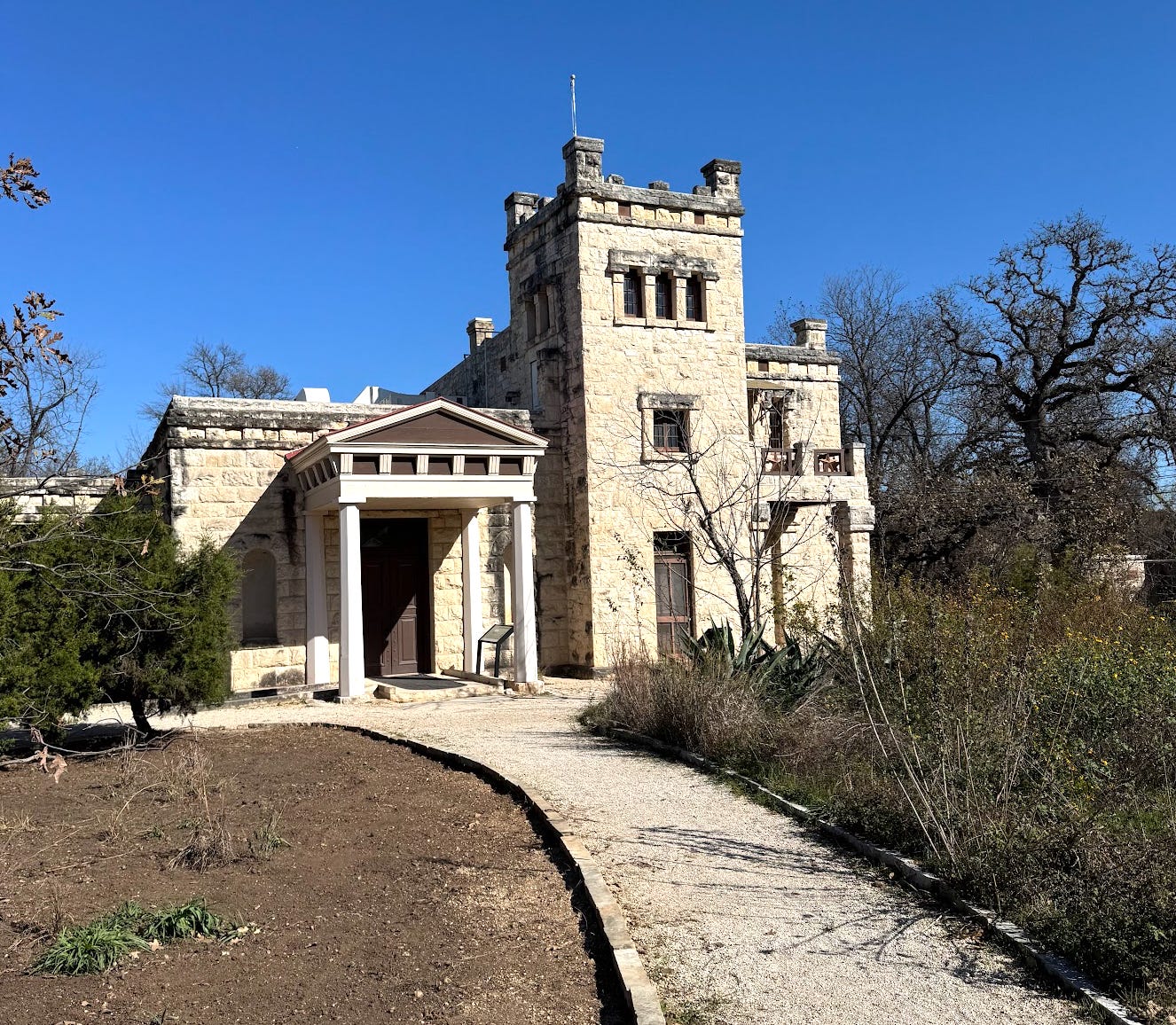We ought to keep together and help each other rising as much as possible. - Elizabet Ney
Greetings to all and wishing you as happy a new year as possible as we hunker down, defending ourselves from Mother Nature. If you are in the Los Angeles area, I hope you and yours are safe from those horrible fires. Many others of us are holed up with blankies and hot beverages, hoping our power grid doesn’t fail as this monster cold front barrels across the country.
Last month when times were better, we took advantage of our typically mild December weather to venture over to Austin for a day trip. I had been meaning to drop in to the Elizabet Ney Museum. I happened to see online that they would be closed for renovations in 2025. As we like to say in these parts, I knew I had to git while the gittin’ was good.
Initially I had planned to go solo. But when I saw where the museum was located, I rolled the dice and asked the hubs if he wanted to come with. My bargaining chip: it was only a few blocks away from one of our favorite restaurants: Home Slice Pizza (the one on 53rd). To my astonishment, he agreed!
Elizabet Ney was completely new to me. When I glanced briefly at the museum’s website, I saw a bunch of fancy white sculptures pictured. I assumed they were part of some rich Austin family’s collection.
Wrong.
When they say ‘her’ sculptures, ‘her’ art, that is literally what they mean. She is the artist.
Like many other artists such as Frida Kahlo, Auguste Rodin, and Georgia O’Keefe, Ney’s former home and studio is now a museum. When she had it built in the late 1890s, it was out in the sticks northwest of Austin proper. Now of course it is completely citified. However she was smart enough to purchase it on some acreage, so there is still a little bit of a buffer zone between it and the surrounding neighborhood.
Elizabet Ney was born in a small town in Germany in 1833. She had one older brother. Her mother was a housewife; her dad, a stonemason.
Turns out Little Miss Ney was quite the contrarian. She had zero interest in following in her mother’s footsteps. But she was definitely interested in following in her dad’s.
Needless to say, women going into the trades was frowned upon in mid-19th century Europe (and everywhere else, for that matter). The closest women might get regarding artistic endeavors was taking up something ladylike, like watercolors or needlepoint. And that was only IF they had any spare time (and money) after they were done bearing the children, raising the children, educating the children, cooking, cleaning, gardening, and everything else required to manage the trad middle class household.
What really cracked me up about this part of Ney’s story was the inspiration for her becoming a sculptor. Apparently her mom was very religious (Catholic) and often told her the story of how the sculptural decor of the Strasbourg cathedral in the 1300s was finished by a woman after her sculptor father passed away. Mother Ney meant it as tale of pious devotion. But young Elizabet’s takeaway was: women can sculpt!

Elizabet demanded to be allowed to study sculpture. Her folks flatly refused. So she went on a weeks-long hunger strike. She wore them down. Eventually, she won. Ney compromised on a few key points; specifically, which school she would attend. But a win was a win, and off she went to the big city of Munich.
There was a bit of pearl-clutching at the Munich Academy. They didn’t want to accept a woman. But Ney worked her magic. This time it didn’t involve a hunger strike; just the art of persuasion that served her time and again throughout her career.
When she finished her studies in Munich, she moved on to the art big leagues of Berlin. She continued to progress in both her studies as well as pursue a relationship with her future husband, the Scottish physician Edmund Montgomery. Elizabet learned how to play the game: ferret out the rich and influential who would be likely to want a bust or full size portrait of themselves. Politicians (Otto von Bismarck). Celebrities (Jacob Grimm). Kings (Ludwig; George).
Elizabet could schmooze with the best of them. But for some reason, she and Edmund decided they had had enough of the Old World and were ready for a change. In 1871 Elizabet, Edmund, and their housekeeper Cencie Simath set sail for America. They bounced around a little (Georgia; Wisconsin) before deciding on Texas.
Initially they purchased a former plantation called Liedo near Hempstead. Ney took a long break from sculpting as they tried to make a go as gentlemen/women farmers. But about the only thing Ney succeeded at during the next twenty years was shocking the locals by cutting her hair and wearing pants. Pants! And riding astride!
Fun fact: the local mill owner considered shutting down operations whenever Ney rode past because all of his workers were so busy watching her instead of minding their beeswax, and he didn’t want anyone to get hurt.
Eventually Ney decided to return to her sculpture career. It was soon apparent she was not going to be able to make that work in Hempstead. Selling sculpture on the Texas frontier would be like trying to interest your teenager in a PBS subscription. In the Hempstead area, it just was not on the radar of most folks and if it was, it was far below other priorities.
So she borrowed some money (they were almost always short on funds) and built her combination home and studio, which she named Formosa, near Austin in 1892. The logic presumably was to be closer to people who were more likely to commission her work (the government, politicians, rich people).
It took time, but Ney finally started to see some commissions trickle in. In the final decades of her life, she created sculptures of many famous personages from Texas history, including Stephen F. Austin, Sam Houston, and Albert Sidney Johnston. Some of her works were displayed at the World’s Fairs in Chicago and St. Louis. Today her statues of Austin and Houston greet visitors at the south entrance of the state capitol.
Ney’s home became a popular gathering spot for the artsy crowd. She maintained her reputation as a cultural oddity. But it seems that perhaps Austin was already feeling weird and was a little more welcoming of the art vibe than Hempstead had been. She made many friends in the community, especially women. The Ney quote that starts this article is part of a longer passage referring to women lifting each other up.
I regret I don’t have the space to include more Ney factoids (her husband was more than a little bugged that she insisted on keeping her maiden name; her surviving son was a real handful; some folks theorize she might have been a spy for Otto von Bismarck). She passed away in 1907 and is buried at Liendo.
I hope this inspires you to dig a little deeper about this fascinating artist. When her museum reopens in 2026, drop in to check it out. And don’t forget to visit Home Slice when you’re done!
I will leave you with three things:
I enjoyed learning about Elizabet Ney, but I also learned so much about the process of creating a sculpture. I was such a newb. For instance, I thought the artist just went after a block of marble with a chisel and months/years later, voilá. That is pretty much NOT what happens. Ney and many others often sketched a portrait first; then created the 3D version in clay/plaster. If and when it ever sold, the marble came later. This is a cool video of the clay process.
Speaking of cool, check out this video about something called a pointing machine, which served as sculpting high tech in Ney’s day. Definitely worth a watch.
Now this was just downright spooky: my main source for this article is a biography of Ney by Emily Fourmy Cutrer. In her acknowledgments she mentioned my alma mater, the University of Texas at Arlington; specifically, one of their history faculty, Sandra L. Myres. Myres’ name rang a bell. I checked the ancient paper copy of my master’s thesis (yes I am a hoarder), and sure enough, Myres was on my thesis committee. Small world.
My latest book, Double Fault, is available now on Amazon.
When an investigation of illegal match fixing by the Russian mob brings the FBI to her tennis club in the person of hunky agent Wilson DuBois, Veronica Burk vows to help him solve the case quickly before her own very successful gambling habit falls under suspicion.
My historical fiction book, Ventured, is also available now on Amazon.
When she takes a chance on making a new life for herself, French orphan and cutpurse extraordinaire Belle must find a way to survive in the New World—or she may not live long enough to enjoy it.
My YA trilogy is also still available if historical fiction isn’t your thing. Hope you enjoy it.
Brody Morgan grew up starring in commercials for his dad's mega food corporation. What will Brody do when he discovers what he's really been selling?










Enjoyed reading about this strong woman who knew her own mind and wasn't afraid to be her true self. That museum looks cool, it's like a mini fortress. Also just love the sunshine in that picture!
A very interesting read. I will share this with my daughter, who has a fine arts degree and lives in the southern US. I’m going to watch that sculpting video now because I have the same erroneous idea that you had.